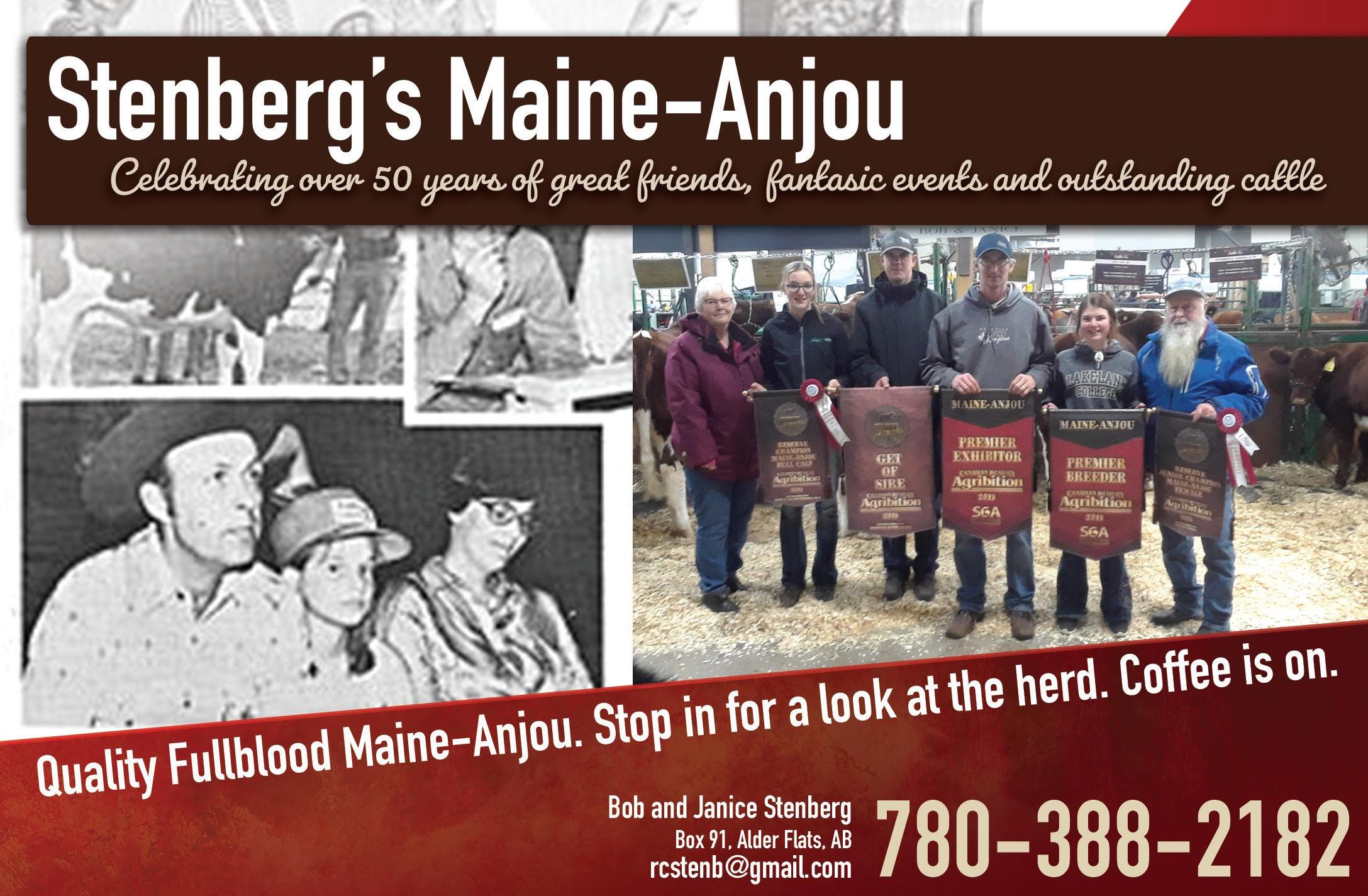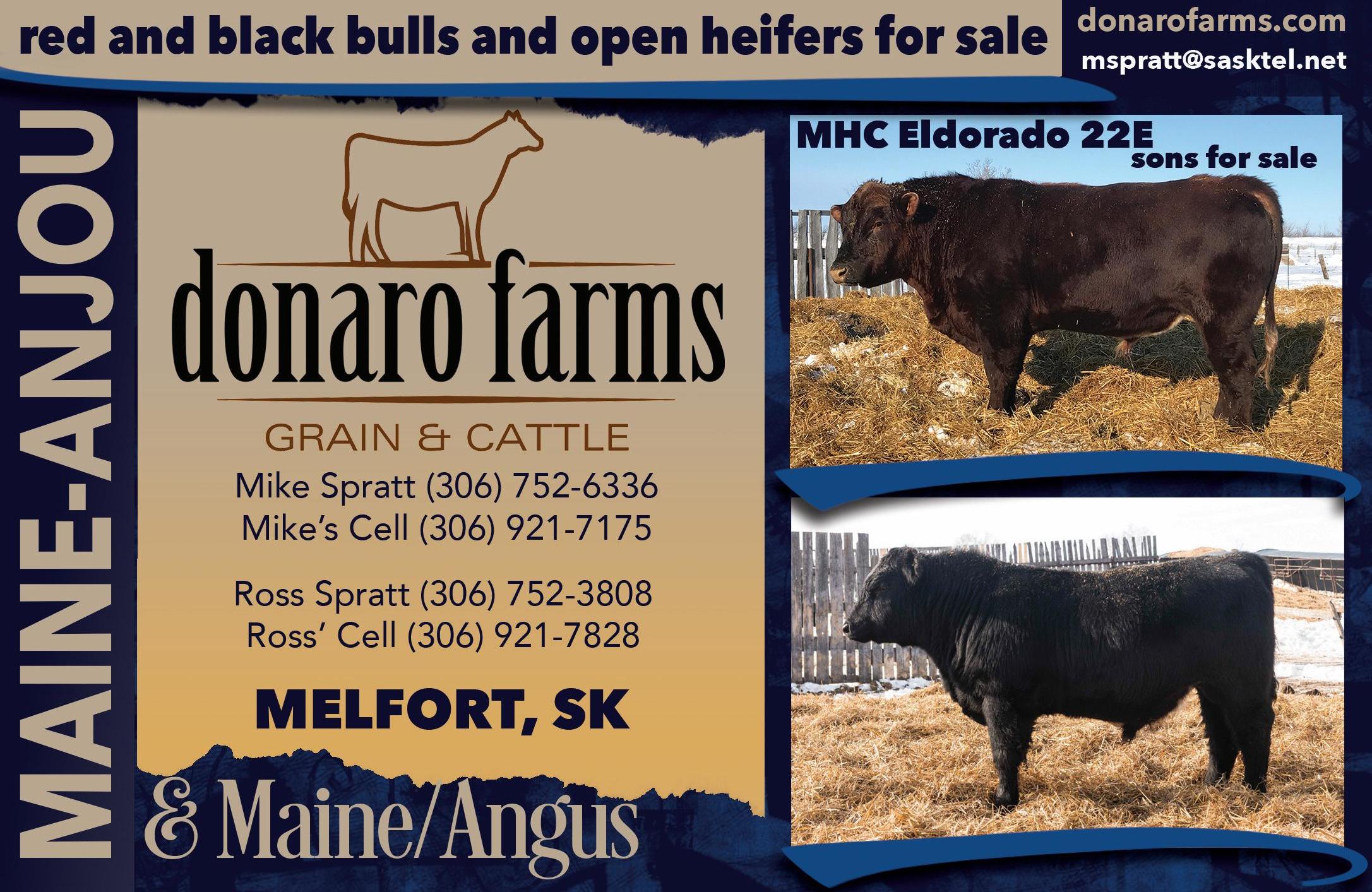
9 minute read
THE 70S
In the late 1960s, the world of Canadian agriculture, particularity beef production was expanding rapidly. Many ranchers were experimenting with new breeds, more sophisticated recording systems for pedigrees, and scientific advantages.
It was into this eager, experimental climate that the Maine-Anjou breed was introduced to Canada in 1969. The first animals were the typically French, fullblood animals and were introduced through quarantine stations.
The first Maine-Anjou animal imported to Canada was a fullblood heifer bought in April 1969 by Donald McQ. Shaver of Galt, Ontario. The three Shaver bulls, Buret, Berlin, and Bysantin were the first bulls imported into North America.
The original group of ‘Maine Men ’ in Canada is widely regarded as Donald Shaver, Stan Spicer of Sundre, Alberta, and Harold Biensch of Neilburg, Saskatchewan.
The Canadian Maine-Anjou Association was formed and incorporated in 1970 under the authority of the Livestock Pedigree Act and the Canadian National Livestock Records. The original office was located in Edmonton, Alberta. The same year, the International Maine-Anjou Association was organized in the United States.

The first animal registered in the Canadian Maine-Anjou Association herdbook was Cygne, and the first registration certificate was issued on December 21, 1970.
The association had its first general meeting at the Corona Hotel, Edmonton, Alberta on April 12, 1971. There were over 50 persons in attendance. The first officers of the association were: Dr. Frederick George Day, President, Graham Ward Jones, Harold Biensch, Dr. John Louis Gulley, Frank Jacobs, and Douglas G. Blair. Another first was the Canadian Maine-Anjou Association Sale, also held in Edmonton on October 20, 1971.
The animals themselves excelled quickly in North America, with Maine-Anjou cross steers earning the highest profits of all breed crosses at the 1971 Exotic Beef Cross Test, at the University of California.
Things developed very quickly for the association and the breed in these early days in North America. The ‘ exotic breeds ’ were very popular, and Maine-Anjou ’ s were no exception, virtually exploding onto the scene in the first years after their arrival. In January 1972 the Canadian Maine-Anjou Association office was moved to downtown Calgary. In 1973, a Maine sired steer was declared Reserve Grand Champion at the International Livestock Show in Chicago. A Maine was the top gaining bull at the Iowa Beef Improvement Association Sioux City Test Station and the Performance Registry International certified the bull Caqui (Prince Maine) as a golden certified meat sire. Several other bulls have since been similarly honoured. At the Calgary Sale that year, Bysantin, the first MaineAnjou herd sire with the most progeny of any Maine-Anjou bull in North America, sold for $100,000, and Maine-Event, a junior herd sire, sold for $53,000. This sale was also the first North American offering of purebred Maine-Anjou cattle. By the end of 1973, the association had recorded its 500th member in Mel Wolfe of Douglas, Manitoba. In just one more year it would exceed 1000 members.
Notable events in 1974 included the birth of the first purebred (7/8) Maine heifer calf born in North American on April 13. The inaugural Eastern Canadian MaineAnjou Sale was held in Guelph, Ontario on August 26. Show results were no less spectacular, with Maines winning Grand Champion and Reserve Champion in the commercial steer and carcass class at the Pacific National Exhibition, Vancouver, British Columbia, Reserve Grand Champion at the National Western Stock Show, Denver,
1. MAINTENANCE of pedigree records and issuance of papers on all purebred and upgraded Maine-Anjou cattle.
2. PROMOTION of importation, breeding, and raising of purebred and upgraded Maine-Anjou cattle throughout Canada.
3. TO ASSIST farmers, ranchers, and cattle breeders in importing, exporting, breeding, raising, and selling purebred and percentage Maine-Anjou cattle.
Colorado, and Grand Champion at the Houston Stock Show in Texas. While in Houston, PTR Epic 83E (also known as PTR Epinal 83E), bred by Harold Biensch of Neilburg, SK set a world record price of $102,000. This animal was the product of the first successful embryo transplant in Canada, off the great cow Cette-la. The renowned bull PTR Epinal 81E was also a product of the transplant. Later that year at the World Sale at Calgary, a fullblood heifer tied that price.
In June, Canadian delegates joined those from England, France, New Zealand, Scotland, and the US in Kansas City, Missouri, for the first World Maine-Anjou Conference and formed the World Maine-Anjou Council. Elected to the Board of Governors of the council were: Arthur Greenhalgh, Dick Sneddon, E. Label, Louis Fourmond, George Linder (can ’t make this out), Douglas and Phil Graham, Cy Hayes, Capt. Gideon Rutherford and Calvin Fryar.
The Canadian Maine-Anjou Convention in November also saw the birth of the ladies Maine-Anjou organization, Maine-Anjouettes, a women ’ s organization designed to promote the breed, sell promotional material throughout Canada at the two National sales and the provincial sales, and to give the ladies an opportunity for involvement, with 48 members.
Further expansion of Maines across Canada continued with a trip to Western Feedlots in 1974 by Carl and Joyce Torio of British Columbia. The visit served as a springboard for Maine ’ s introduction into the Peace Country. Upon seeing a pen of Bruce Barkley ’ s crossbred Maine steers on feed, Carl was sold on the breed. The Torio ’ s began buying Maines for the breeding programs immediately, and in 1977 began feeding crossbred Maine steers at the Peace River Cattle Company, selling the finished cattle to the Dawson Creek package plant. The Torio ’ s further pushed Maines by leasing bulls to their neighbours with a purchase option on the calves at weaning of a one-cent premium over the Dawson Creek Market, resulting in leasers (and some eventual buyers) that were very happy with their Maine cross calves. Carcass division at Canadian Western Agribition, Regina, Saskatchewan, Reserve Grand Champion, Farmair, Edmonton, Alberta, Reserve Grand Champion Carcass at the Houston Livestock Show, Texas, Grand Champion Carcass at the New Mexico State Fair, Grand and Reserve Grand Champion Carcass at the Pacific National Exhibition in Vancouver, British Columbia, the Grand Champion over 500 entries at the El Paso Stock Show, Texas, and the Queen ’ s Guineas at the Royal Winter Fair, Toronto, Ontario. Maines also topped the feedlot and economic tests in the 1975 Montana State Steer Futurity, as they had in previous years.
In 1976, the profile of Maines continued to increase both in and out of the show ring. First, a set of triplets (all bull calves) was born on the ranch of Bruce and Lois Barkley at Cochrane, Alberta on March 30. they were sired by Caqui and out of a commercial black baldy cow. Then, the first purebred domestic bull calf was born at Triple V Farms at Crossfield, Alberta. The calf, weighing 85 lbs., was sired by Shaver Grenedier and out of the first domestic purebred Maine cow in North America. In the show ring, Maines winning ways continued with Grand and Reserve Championship titles at the Atlantic Winter Fair, high-seller at Farmfair, and Grand Champion Steer at the Houston Livestock Show, beating 1,149 other entries. Maines also stood out in scientific studies, ranking highest in every aspect except calving ease in the Nebraska Germ Plasma Evaluation in the US.
1977 was another banner year, with Maines winning Grand and Reserve Grand Champion Steer at both The National Livestock Show in Denver and the San Antonio Stock Show. They also took home both Grand and Reserve Champion titles in the Junior Futurity Class (comprised of Simmental, Sales, and Maine-Anjou heifer calves) at Farmfair. Perhaps most exciting in the show ring was the presentation made to Vern Croy of Stonewall, Manitoba, for his win in the Grand Champion Market Steer at Canadian Western Agribition by His Royal Highness Prince Phillip.
The 2nd World Maine-Anjou Show, held at the Calgary Stampede, comprised over 100 entries and was the second-largest breed show at the Stampede. The 5th
Annual World Maine-Anjou Sale, held in conjunction with the show, drew over 60 lots and was described as the most highly selected, quality offering of fullblood, purebred, and percentage Maine-Anjou breeding stock available anywhere to date. Maine-Anjou breeders also made their mark on the Stampede Parade, as the float of the Foothills Maine-Anjou Association was named the winner in the Amateur Float Contest with their colourful, mobile, Maine cow and calf exhibit. A notable appearance at the World show was by Senator Harry Hayes of Calgary, Alberta, as the judge.
Also in 1977, the Canadian Maine-Anjou Association Sire Progeny Test was initiated. The office moved from downtown Calgary to the Transcon building on April 1. The first 15/16 polled Maine born in Canada was a 105 lb. heifer calf as a resulting from a single egg transplant from a 7/8 Cunia daughter to a Holstein replacement cow born at Emmore Farms of Elm Creek, Manitoba on June 17. Cornerstone, the first 15/16 Maine bull was also born on August 27. As of January 1, 1978, the registry was transferred from the CNLSR in Ottawa to the CMAA headquarters in Calgary and was computerized.
The breed continued its success in the show ring in 1978, winning six Grand and Reserve Grand Championships Market Steers at Canadian Western Agribition, Grand Champion Jackpot Steer at the Saskatoon Fall Fair & Mexabition, Grand Champion Steer at the Royal Agricultural Winter Fair, Reserve Champion in the Carcass class at Agribition, and Reserve Grand Champion Market Steer at Farmfair.
In 1979 the first National Maine-Anjou Bull Test was completed at Rocky Mountain House, Alberta on April 12. 65 bulls finished the test with an ADG of 3.385 lbs. per day. On the 28th, the top 45 bulls were sold in Red Deer, Alberta, averaging $1763. The program was such a success that it became an annual event. At the 5th annual performance tested bull sale in Tipton, Indiana, organized by the Indiana Beef Evaluation Program (IBEP), the

highest indexing and top gaining bull was a 3/4 MaineAnjou which had gained 3.75 lbs./ day, weighed 1,521 lbs. off test, and had an IBEP spring test rating of 121.2, the highest of 111 bulls tested.
It was also the year of the inaugural National Pasture Showcase Heifer Program. This was a promotion, sponsored by the Foothills Breeds Club, that grazed a group of Maine-Anjou females in a highly visible area alongside a main highway. Also in Alberta, the HiNeighbour Steer Project placed almost 50 Maine-cross steers, purchased at fall feed sales by the Alberta Association, with Maine breeders. The breeders finished the steers for free and turned the proceeds over to the association at sale time. The funds raised were for the hire of an Alberta Fieldman.
Maine Man Leonard Gustafson of Macon, SK was elected to the House of Commons in 1979 as a member of the Progressive Conservative Party. He went on to have an illustrious political career that was still continuing during the publication of this history book in 2005, including reelections to the House in 1980, 1984, 1988, and appointment as Secretary to the Prime Minister from 1984 to 1991 and an appointment to the Senate in 1993.
Also in summer 1979, four Maine-Anjou bulls arrived at Canada ’ s largest Hereford ranch, Douglas Lake Cattle Company. Results were described as excellent and the opportunity this provided to expand into British Columbia was tremendous.
By the close of the decade, the association had expanded to include 1,500 members and 40,255 recorded, and 3,374 registered animals.




